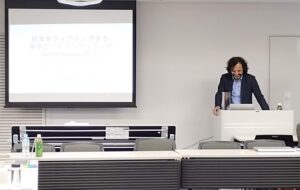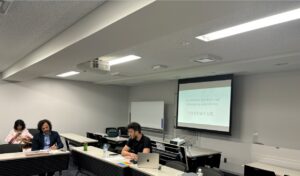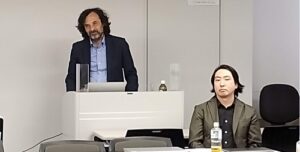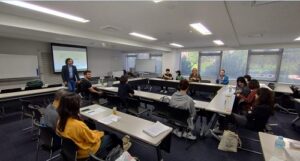【Event Report 】Hosei University Research Center for International Japanese Studies Transnational Japan Workshop Series(4) “Queering” Japanese Culture June 13th (Thu), 20242024/08/09
Hosei University Research Center for International Japanese Studies
Transnational Japan Workshop Series(4)
“Queering” Japanese Culture
「クィア」から見る日本文化
■ Date/Time: June 13th (Thu), 2024 17:30~20:00
■ Location: Hosei University Ichigaya Campus, Shin Mitsuke Building, 3rd FL Room A 305
(Face-to-face format)
■ Presenters:
Thiery Hoquet (Université Paris Nanterre)
Pierre Niedergang (Université Paris Nanterre)
■ Chair: Kei Takata (Hosei University)
Hosei University Research Center for International Japanese Studies has been hosting a series of workshops that look at Japanese society, culture, and politics from a transnational perspective. This time, we invited two scholars from France to analyze Japanese arts and pop culture, as well as communication culture, from a “queer” perspective. To accommodate two theoretically rich presentations within the limited time and to foster lively discussion, we applied a flexible format where we mixed multiple languages with the intervention of interpretations only when necessary.
First, Professor Thierry Hoquet at the Université Paris Nanterre presented a paper entitled “Queering Japan: a Verfremdung [estrangement] of Bodies and Identities” in Japanese. Hoquet proposed a broader concept of “queer.” According to Hoquet, “queer needs to be understood as an objection toward fixed identities” rather than just one category of LGBTQ. By evading dualisms such as female/male and heterosexual/homosexual, what he calls “queering” aims to expand the range of presupposed identities and open up new possibilities for human nature. Through this concept, Hoquet analyzed a wide variety of “queer” portrayed in Japanese art and culture, including contemporary artist Yasumasa Morimura’s photo “Elder Sister,” Toshio Matsumoto’s film “Funeral Parade of Roses,” Yukio Mishima’s novel “Forbidden Colors,” and Gengoro Tagame’s manga “My Brother’s Husband.” His analysis of “Elder Sister,” a photograph taken by Yasumasa Morimura himself dressed as a woman, was particularly thought-provoking. According to Hoquet, the queerness of “Elder Sister” can be comparable to that of science fiction. Although science fiction lacks empirical or objective proof, the possible existence of the world portrayed in SF cannot be completely denied. Thus, the imagination of science fiction has the power to “estrange [verfremdung]” our reality and explore a better future. Hoquet emphasized that “queering” has a similar “estrangement effect [verfremdungseffekt]” that is open to alternative possibilities.
The second presentation, “Queering Aida (間)” by Dr. Pierre Niedergang, attempted to analyze the relationship between queerness and norm by referring to the Japanese concept of “aida (in-between).” According to Niedergang, norms are constituted within “aida,” and as Foucault pointed out, such norms are not neutral, and “biopolitics” is latent. Thus, norms are socially constructed. Based on such understanding, Niedergang asks whether the “aida (in between)” is constituted by heterosexual norms. Existing queer theories have argued that sexuality has specific norms, which are the result and the relay of relations of (heterosexual) domination, and thus, all norms concerning sexuality need to be criticized and evacuated (i.e., anti-normative queer theory). Rather than simply criticizing the dominant norm, Niedergang goes beyond and proposes to invent new norms of “aida (in-between).” There is a particular kind of normativity outside of heterosexuality, a sort of queer normativity, which is expressed, for example, as sexual consent. And in conclusion, he identified three keywords as characteristics of queer normativity: critical, communitarian, and vital.
Two presentations were a unique attempt to conceptualize queerness in a new and distinct way while intersecting Japanese culture and philosophy with Western theory. Furthermore, both presentations proposed an important point that queer is not only an approach to dismantling dominant culture and norms but also a methodology that opens to alternative possibilities. Following two presentations, we held a lively discussion in Japanese, English, and French with participants from diverse backgrounds. The seminar was an occasion for mutual learning, with comments and questions from a variety of perspectives – including theoretical, historical, and comparative analysis of the differences between Japanese and Western queer culture, the evolution of queer images from the 1970s to the present, the possibilities for queer communication in contemporary Japan, and the conceptual differences between “ma” and “aida,” etc. The workshop was an enriching opportunity for the participants to learn from each other through impressive presentations and engaging discussions.
Kei Takata (Hosei University)
 【Thiery Hoquet】 |
 【Pierre Niedergang】 |
 【Thiery Hoquet Kei Tkata】 |
 【Scene from the Event 】 |

